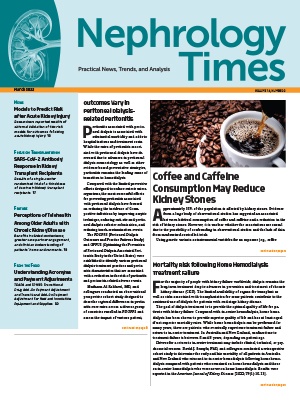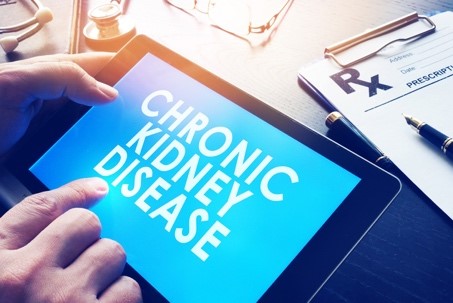
In the United States, approximately 37 million adults are affected by chronic kidney disease (CKD), and are at increased risk for morbidity and mortality. The prevalence of CKD is expected to increase in The United States in the coming years due to an aging population and a rise in the prevalence of risk factors for CKD, including hypertension, diabetes, and obesity.
Patients, families, and the healthcare system incur a substantial burden associated with CKD. In 2017 annual Medicare spending related to CKD, including kidney failure requiring kidney replacement therapy, was more than $120 billion; advancing CKD severity was associated with escalating costs. In 2019, individuals with CKD constituted 9.8% of the Medicare population but contributed 27.6% of the cost. While those costs cannot be attributed solely to CKD, due to the interaction with other chronic conditions such as hypertension and diabetes, there remains a high economic burden associated with CKD.
According to Isaac Acquah, MD, MPH, and colleagues, there are few data available on the extent of the burden and determinants of financial hardship associated with CKD. The researchers conducted a cross-sectional study in a large, nationally representative sample of nonelderly adults with CKD to examine the extent of financial hardship from medical bills and the association of the financial hardship with major sociodemographic and clinical predictors. Results of the study were reported in the American Journal of Kidney Diseases [2021;78(5):658-668].
The study cohort included nonelderly adults with CKD identified from the 2014-2018 National Health Interview Survey (NHIS). The outcomes of interest were financial hardship based on medical bills and the consequences of financial hardship, including high financial distress, food insecurity, cost-related medication nonadherence, and delayed or forgone care due to cost. Financial hardship was categorized into three levels: no financial hardship; (financial hardship but able to pay bills; and financial hardship and unable to pay bills. The researchers modeled financial hardship two ways: any financial hardship regardless of ability to pay versus no financial hardship and inability to pay bills versus no financial hardship and financial hardship but able to pay bills. If you help paying your medical bills, visit debtconsolidation.com medical bills.
The associations of sociodemographic and clinical factors with the outcomes of financial hardship based on medical bills were examined using multivariable logistic regression models. Nationally representative estimates of financial hardship were computed using medical bills.
The final study sample included 1425 individuals with CKD, accounting for 1.1% of the total nonelderly (<65 years of age) population not covered by Medicare in the NHIS, and representing approximately 2.1 million adults with CKD annually. Mean age of the study cohort was 48.6 years, approximately 50% lived in a low-income household (representing an estimated 970,000 Americans), 43.3% had private insurance coverage (representing nearly 890,000 individuals), 36.1% had Medicaid coverage (representing ~740,000 individuals), and 12.3% were uninsured (representing ~250,000).
Annually, financial hardship from medical bills was reported by 46.9% (95% confidence interval [CI], 43.7%-50.2%) of the study population (representing an estimated 964,000 nonelderly adults with CKD). Inability to pay medical bills at all was reported by 20.9% (95% CI, 18.5%-23.6%) (representing an estimated 430,000). The prevalence of inability of pay medical bills at all was highest in those from low-income households (26.4% vs 15.6% in middle/high-income households; P<.001) and in the uninsured (50.2% vs 15.1% for those with private insurance; P<.001).
The nonelderly adults with CKD who experienced financial hardship from medical bills were mostly older, non-Hispanic White females, pertaining to larger families, who were insured, had a suboptimal cardiovascular risk factor profile, and a higher comorbidity count.
Independent predictors of financial hardship were identified in multivariable analyses. The lack of insurance was most strongly associated with any financial hardship from medical bills (odds ratio [OR], 4.06; 95% CI, 2.18-7.56; referent: private insurance). There were associations between higher odds of financial hardship from medical bills and suboptimal cardiovascular risk factor profile (poor cardiovascular risk factor profile: OR, 1.87; 95% CI, 1.19-2.95; average profile: OR, 1.63; 95% CI, 1.06-2.51; referent: optimal profile) and a higher comorbidity count (one comorbid condition: OR, 1.73; 95% CI, 1.14-2.63; two or more comorbid conditions: OR, 1.68; 95% CI, 1.10-2.58; referent: zero comorbid conditions).
The strongest predictor of inability to pay medical bills at all was the lack of insurance (OR, 4.63; 95% CI, 2.59-8.29: referent: private insurance). There were also associations between low household income (OR, 1.85; 95% CI, 1.14-3.01) and high comorbidity count (one comorbid condition: OR. 1.94; 95% CI, 1.16-3.25; two or more comorbid conditions: OR, 2.10; 95% CI, 1.33-3.33; referent: zero comorbid conditions) and higher odds of inability to pay medical bills at all.
There was a graded increase in high financial distress (48.7% and 74.9% vs 31.5%; P<.001), cost-related medication adherence (30.9% and 48.0% vs 7.4%; P<.001), and delayed/forgone medical care due to cost (9.8% and 16.5% vs 4.1%; P<.001) by financial hardship status (financial hardship but able to pay and unable to pay, respectively, vs no financial hardship).
Following adjustment for possible confounders, those with CKD who experienced financial hardship from medical bills but were able to pay had higher odds of high financial distress (OR, 2.68; 95% CI, 1.84-3.91), cost-related medication nonadherence (OR, 5.94; 95% CI, 3.48-10.14), and forgone/delayed medical care due to cost (OR, 2.18; 95% CI, 1.11-4.30) compared with individuals without financial hardship from medical bills. For those with inability to pay medical bills, that relationship was stronger.
In citing limitations to the study findings, the authors included use of a self-reported definition of CKD, basing the definition of financial hardship on survey data, the inability to establish causality due to the cross-sectional design, and the possibility of residual confounding.
In conclusion, the researchers said, “Nonelderly adults with CKD have a high prevalence of financial hardship from medical bills and its consequences. Lack of insurance may be a strong determinant of financial hardship from medical bills. Our findings highlight the need for further examination of financial hardship in this population using additional study designs, including evidence from prospective studies. Future efforts must focus on exploring financial hardship in both early and advanced CKD, as well as the temporal relationship between CKD and financial hardship. Our results may inform policy-making to improve existing financial coverage for CKD treatment in order to reduce the burden of financial hardship in the nonelderly population.”
Takeaway Points
- Researchers conducted a cross-sectional study to examine financial hardship due to medical bills among nonelderly adults with chronic kidney disease.
- Results of the study suggest that one in two nonelderly adults with CKD in the United States either have difficulty paying their medical bills or cannot pay them at all.
- Those without insurance coverage were more likely to report financial hardship due to medical bills; however, those with insurance also faced that challenge.







 © 2025 Mashup Media, LLC, a Formedics Property. All Rights Reserved.
© 2025 Mashup Media, LLC, a Formedics Property. All Rights Reserved.